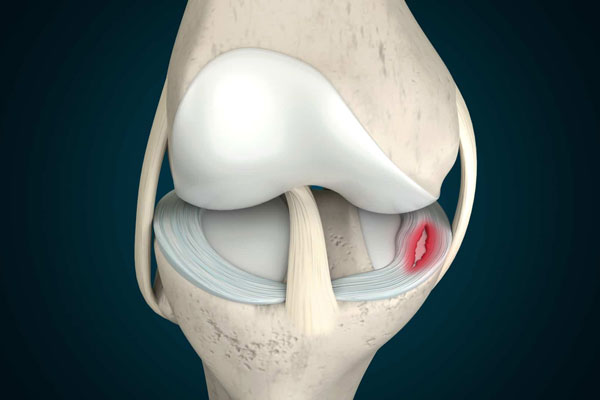Meniscus Tear / Knocked Knee
A meniscus tear is a common problem, especially in people engaging in intense physical activity. Although quite common, this injury can be very painful. However, appropriate measures may help relieve the pain and promote healing of the injured tissue.
What is Meniscus Tear?
Located between the shinbone and thighbone are a pair of C-shaped cartilage pieces. A meniscus tear happens if the knee is twisted by some force or injury. Additionally, occasionally a portion of the cartilage tears and comes loose. It then locks itself up in the knee joint.
A meniscus tear is very common in athletes who engage in sports like football, soccer, or volleyball. It is seen to occur when a person suddenly changes his direction of motion while running or along with other knee injuries like an anterior cruciate ligament (ACL). Meniscus tears are seen to be more frequent in older athletes owing to the weakening of the meniscus as age advances.

What are the symptoms of a Meniscus Tear?
Some of the likely symptoms of a meniscus tear are given below:
- Popping sensation during the injury
- Pain
- Swelling in the knee region
- Feeling of the knee getting “stuck” or lock up
- Difficulty in movement like straightening or bending of the leg
In order to assess if you have a meniscus tear or not, the doctor would require a thorough examination with details about how you got the injury. At times, an X-ray may be called for to rule out broken bones. However, an MRI (Magnetic Resonance Imaging) is advisable to get a more detailed evaluation of the knee cartilage.
How is Meniscus Tear treated?
An important factor in the treatment of the meniscal tear is the location and size of the tear. The outer portion of the meniscus is called the "red zone," as it is richly supplied with blood. If the injury is in this part and is small, it can most likely heal on its own. The inner two-thirds of the meniscus do not have a good blood supply and is named the "white zone. Tears in this area do not heal by themselves as there is a dearth of blood supply that brings healing nutrients to this region.
The treatment also depends on the age of the person, his or her activity levels, and other related injuries, if any. The good news is that not all such meniscus tears require surgery. A bit of self-care goes a long way toward healing the tear. Given below are some tips that can be easily followed at home:
- Take adequate rest: Restriction of movement to just walking will help the knee to recover fast. The use of crutches also helps.
- Apply ice pack: Applying ice packs to the knees reduces pain and swelling to a great extent. It should be done every 3-4 hours for 15-20 minutes for 2-3 days or until the pain wears off.
- Compress the knee region: The use of an elastic bandage or neoprene-like sleeve on the swollen region is known to control swelling.
- Raise your knee: Elevate the knees by propping them up against a pillow, kept under your heel irrespective of whether you are lying down or sitting.
- Taking anti-inflammatory medicines: Non-steroidal anti-inflammatory drugs (NSAIDs) reduce swelling and pain. However, these have side effects like ulcers and an increased risk of bleeding. Hence, these must be taken under the advice of a doctor.
- Exercise: Strengthening and stretching exercises reduce stress on the knees. Such exercises should be done under the supervision of a therapist. Rigorous activities such as jumping or running should be avoided.
The above-stated measures may not always be enough as a treatment. In cases where the tear is large, surgery may be the only resort. It is a pretty simple procedure, and one can go home the day it is performed. If a repair has been made, a brace for protection may be required. For the injury to completely recover, it may take as long as 4 to 6 weeks. In the long term, if a meniscal tear goes unrepaired, there is a risk of developing knee arthritis.
What are the preventive methods of Meniscal Tear?
Meniscal tears are tough to prevent, but one can take certain precautions to reduce their incidence. Follow these measures to ensure healthy knees:
- Exercise regularly to keep your thigh muscles strong. Warm-up lightly before you begin with the exercises.
- Take adequate rest between workouts. Fatigued and tired muscles only increase the risk of an injury.
- Wear comfortable shoes that fit snugly and provide the required support.
- Never increase the exercise abruptly.
